Table of Contents
Food Chain and Food Web:
What is Food Chain?
After the initial production of organic matter by an autotroph, the nutrients and energy incorporated in the autotroph are passed through the rest of the system by heterotrophs feeding upon autotrophs and upon one another. The particular pathway of nutrient and energy movement depends upon which organism feeds upon another. Such a feeding pathway is called a food chain.
In simple words, a list of organisms (living beings) showing “who eats whom” is called a food chain.
Types of Food Chain:
In nature, we come across two major types of Food Chains-
- Grazing Food Chain- The grazing food chain starts from green plants and goes from herbivores (primary consumers) to primary carnivores (secondary consumers) and then to secondary carnivores (tertiary consumers) and so on. Cattle grazing in grasslands, deer grazing in the forest, and insects feeding on crops and trees are the most common biotic constituents of the grazing food chain.
| Autotroph ——–> Herbivore ——–> Primary Carnivore ——–> Secondary Carnivore, etc. |
| Example of Grazing Food Chain in a Pond Ecosystem: Phytoplanktons (Algae, diatoms) ——> Zooplanktons —–> Small Fish —–> Carnivorous Fish |
- Detritus Food Chain- Unlike grazing food chains, the detritus food chains depend upon the dead organic matter either in the form of fallen leaves etc. or dead animal bodies. Hence, these are not directly dependent on solar energy. An example of the detritus food chain is seen in a Mangrove (estuary). Here, a large quantity of leaf material falls in the form of litter into the water. The leaf fragments are eaten by saprotrophs. (Saprotrophs) are those organisms which feed on dead organic matter). These fallen leaves are colonized by small algae, which are also consumed by the saprotrophs or detritivores consisting of crabs, molluscs, shrimps, nematodes, insect larvae and fishes. The detritivores are eaten by small carnivorous fishes, which in turn are eaten by large carnivorous fishes.
| Leaf Litter —–> Algae —–> Crabs —–> Small Carnivorous Fish —–> Large Carnivorous Fish (Mangrove Ecosystem) Dead Organic Matter —–> Fungi —–> Bacteria (Forest Ecosystem) |
Thus the grazing food chain derives its energy basically from plant energy while in the detritus food chain it is obtained primarily from plant biomass, secondarily from microbial biomass and tertiarily from carnivores. Both the food chains occur together in natural ecosystems, but the grazing food chain usually predominates.
Ecological Principles Derived From Food Chains:
- There is a unidirectional flow of energy from the sun to producers and then to a series of consumers in a food chain. Thus a food chain always begins with photosynthesis and ends with decay. Biogenetic nutrients are made available through biogeochemical cycles.
- There is lesser wastage of food energy in shorter food chains. Wastages increases with the length of food chains.
- The size of any population is determined by the number of trophic levels in a food chain. With the decrease in useful energy at each step, there is a decrease in the population size. Thus the size of a population of quaternary consumers is less than that of tertiary consumers and that of tertiary consumers is smaller than secondary consumers.
Significance of Food Chain:
Food Chain studies help understand feeding relationships and the interaction between organisms in any ecosystem. They also help us comprehend the energy flow mechanism and matter circulation in ecosystems and understand the movement of toxic substances in the ecosystem and the problem of biological magnification. Certain harmful substances, usually ones not found in nature but introduced by man, may get injected into plants and or animals. These poisonous substances may not be broken down in the body or excreted easily and quickly. Instead, they accumulate in the tissues, and as the living organisms eat more, the concentration of these substances increases and they pass from one trophic level to the next. Since man is an omnivore and has access to all trophic levels for food, he gets the toxic substances into his body in large amounts. Secondary and tertiary consumers located on top of the food chain also get the poison into their body. This phenomenon is called biological magnification.
What is Food Web?
A large number of food chains exist in a community of living organisms in an ecosystem such as grassland, a forest, a pond or a crop field. Many of these food chains are inter-connected by species (organisms) that occur in more than one food chain. The inter-connected food chains operating in an ecosystem that establishes a network of relationship between various species is called a food web.
Thus, the food web is a network of food chains where different types of organisms are connected at different trophic levels, so that there are a number of options of eating and being eaten at each trophic level.
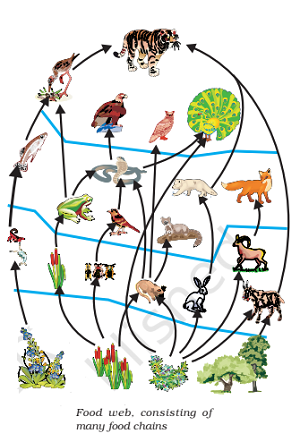
Features of a Food Web:
- In a food web, no food chain is independent and no linear arrangement of food chains occurs.
- It is formed by the interlinking of food chains.
- It provides alternative pathways of food availability i.e. if a particular crop fails, the herbivores graze on other types of crop. Thus, the greater the number of alternative pathways, the more stable the ecosystem.
- It helps in checking the overpopulation of highly fecundive species of animals and plants.
- The position of an animal in a food web is determined by the age and size of the species and the availability of food source.
- It helps in ecosystem development.
Significance of Food Web:
- Concept of food web is more real ecologically than simple food chains.
- It provides for alternate sources of food.
- None get starved if its preferred species is reduced in number. The animal switches over to alternate food item.
- No species is exploited beyond the degree of its recovery.
- It provide stability to ecosystem.
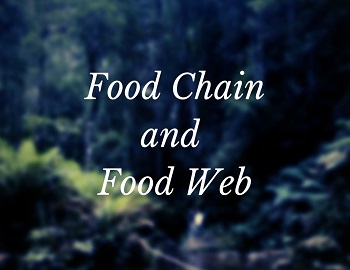

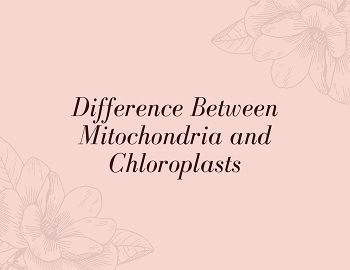

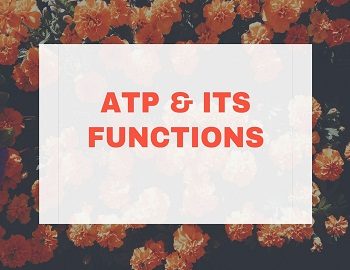



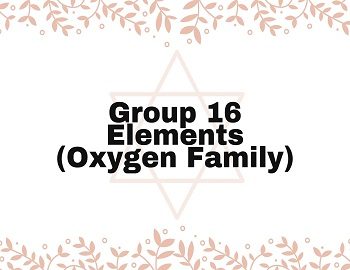
Comments (No)